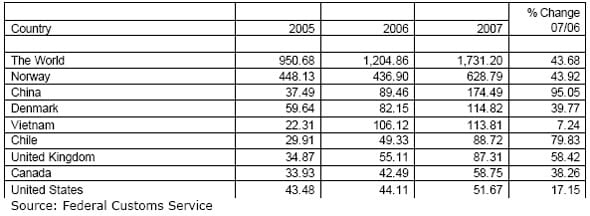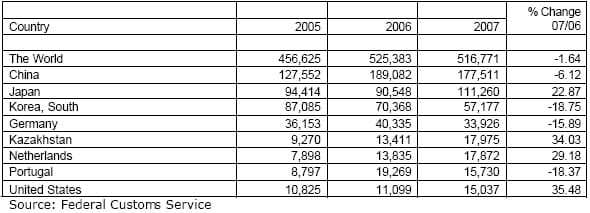Executive Summary
Exports declined to $517 million, a near 2-percent decrease from the previous year. Russia’s trade deficit in the fishery sector increased 79 percent, reaching $1.2 billion in 2007. Significant increases in fish and fish product imports can likely be attributed to increased domestic consumption of these products, higher prices for products such as beef, pork, and poultry, and the new eating habits of Russian consumers. Although Norway remains the leading supplier of fish and fish products to Russia, other countries have increased their share in the Russian market, such as China and Vietnam. The United States increased its export of fish products to Russia by more than 17 percent in 2007.
Table 1: Russian Federation: Imports of Fish and Fish Products, by Country of Origin, Jan-Dec, 2005-2007, million dollars.

Table 2: Russian Federation: Exports of Fish and Fish Products, by Country of Destination, Jan-Dec, 2005-2007, million dollars.

Fishery Trade with Norway
According to Norge Fish Co., imports of Norwegian fish and seafood products increased from 286,000 metric tons (MT) in 2006 to 410,000 metric tons in 2007; the value of those imports increased by 28.5 percent from $498 million to $637 million. It is estimated that 73 percent of all fish and fish products (more than 2,000 varieties) from Norway are shipped to the EU and Russia. Norge Fish Co. reports that in 2007, Norway exported 85 percent of its total herring production to Russia, as well as 33 percent of its sprat and 23 percent of its capelin and mackerel. Import of these commodities from Norway is expected to increase approximately 20-25 percent. Imported herring saw a 251,000 MT increase in 2007 versus 2006. Imports of Norwegian herring increased 24.1 percent, reaching 216,000 MT. However, Iceland decreased shipments of herring from 12,000 MT in 2006 to 4,000 MT in 2007. Domestically produced herring accounted for 58 percent of the Russian market.
In 2007, the total export of pelagic species from Norway continued to increase. According to the Norwegian Committee of Fish Exporters, the total value of exported fish in 2007 is estimated at $1.1 billion, which is a 12-percent increase from 2006. The value of herring exports reached $600 million, $66 million more than in 2006, while mackerel exports reached $300 million, an $18.1 million increase from 2006.
Consumption
According to some market analysts, Russian fish and fish product consumption increased 17 percent in 2007. Although fish is third to red meat and poultry in quantity consumed, the consumption of fish and fish products is rapidly growing in Russia, particularly in major metropolitan areas such as Moscow and St. Petersburg. According to Gennadiy Ufimtsev, Deputy Head of the Moscow Department of Food Resources, the daily average consumption of food products in Moscow increased to 31,200 MT in 2007, a 1,200 MT increase from 2006. According to the investment group Norge Fish Co., since 2006 the total consumption of fish and fish products in Moscow has increased by 78.6 percent.
Market analysts predict that this trend in fish and fish product consumption will continue due to consumers’ increasing disposable income, changes in consumer preference towards healthy and high quality food, increased availability of products, increased investments in processing industries, and improvements in distribution and supply chains.
Production Developments
The State Fisheries Committee (GosKomrybolovstvo) announced plans to build a large wholesale fishery market near Moscow. Press reports indicate that the selected location will be close to railway stations and airports in order to facilitate the delivery of fish and other seafood products from the Far East and Kamchatka Peninsula. The new project will consist of a fish processing facility, cold storages, and trading floors.
As outlined by the federal targeted program on the development of the Russian fishery sector, more projects will be launched in the near future. The Moscow-based company Brig- Star, in conjunction with the Rostov oblast administration, will construct a processing facility estimated at Euro 60 million ($95.5 million). The facility is expected to produce 5,000 MT of fish annually. Brig-Star was founded in 1998 and specializes in the wholesale trade of frozen fish and seafood. Rostov oblast is one of the most attractive regions for fresh water fish production and boasts a significant number of fish hatcheries and a solid feed base. There are 381,000 hectares of natural fishing reservoirs in the region. The company will be actively involved in the production and processing of fish preserves.
According to Norge Fish Co., in 2006 the production of fish preserves accounted for 8-10 percent of total fish production in Russia, or 300,000 to 500,000 MT. According to the Federal Statistics Service (Rosstat), total production of fish products in Russia is estimated at 3.6 million MT. The domestic retail market share of fish preserves is only 20 percent. Furthermore, producers only meet 50 percent of retail demand for this product. As a result, from 2004-2006 the import of fish preserves has increased more than two-fold. In 2007 Russia’s imports of preserves accounted for 80,000 MT, or $35 million in value.
According to sources at Norge Fish Co., 70 percent of total fish processing is carried out on the vessel; whereas, coastal processing and industrial processing account for less than 25-30 percent.
Salmon Catch
According to Primorye press reports, the Russian salmon catch has been very successful for the last decade, exceeding 200,000 MT. In 2007 total salmon caught was 450,000 MT. However, trade sources expect this number to decrease in 2008. In the Far East, pink salmon accounted for 260,000 MT, chum and sockeye salmon 53,500 MT and 31,100 MT, respectively. Experts estimate that at least 100,000 MT of salmon was caught by poachers.
Salmon is traditionally one of the most popular species consumed by Russians. Salmon imports will continue to increase due to rising income and a desire for more nutritious food. Norway is the largest supplier of salmon to Russia. This trend is expected to continue in the future due to increasing consumer demand and a limited domestic supply of salmon due to fleet depreciation and poaching.
Prices
According to Rosstat, fish and seafood prices increased 8 percent in 2007. Moscow retail outlets continue to offer a wide selection of both traditional products (herring, mackerel, salmon) and exotic items , such as squid, prawns, mussels, and oysters. The supply of both chilled and processed European seafood is highly diversified but prices are tailored to an upper-middle class customer. However, prices for fish in outdoor markets are often half the price, depending on the product, of that at the supermarket. The price for chilled salmon from Norway is approximately 230 to 280 rubles per kilo, while the price for pink salmon from the Far East is 100 rubles per kilo. However, the price for the same product at Sedmoy Continent is as high as 650 rubles per kilo. The price difference between outdoor markets and supermarkets for frozen pollock and hake ranges from 90 rubles to 150 rubles per kilo. Most Muscovites prefer to buy fish in open markets due to the lower prices, although Auchan is increasingly popular, as it offers a wide range of products at competitive prices.
Further Reading
| - | You can view the full report by clicking here. |
April 2008

